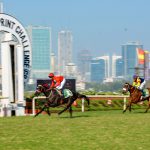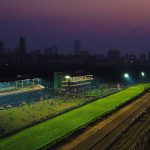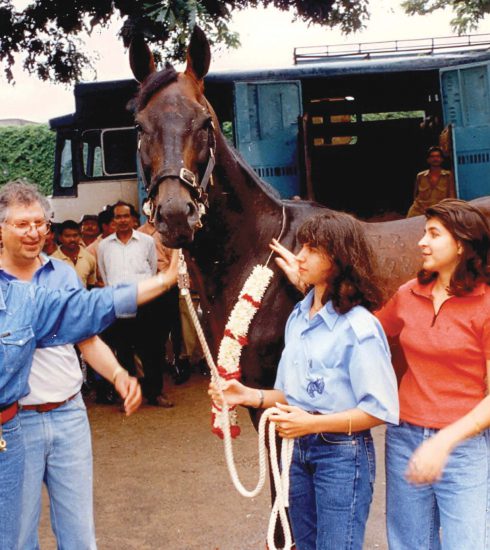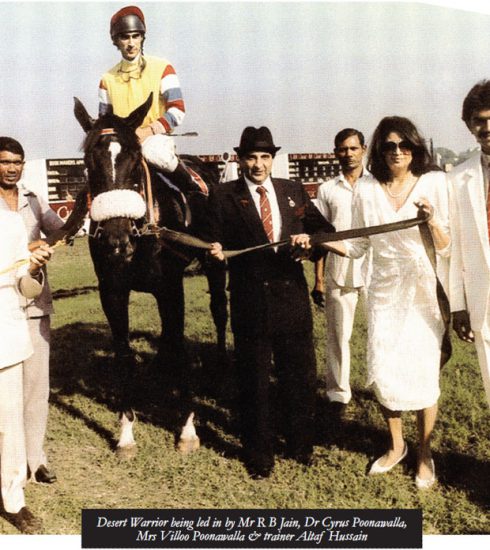PIGSTICKING
“Over the valley and over the level,
Through the rough jungle, now go like the Devil.
There’s nullah in the front but a boar as well,
So sit down in the saddle and ride like hell.”
 That fragment is from a pigsticking ditty. Pigsticking ? What’s that ?
That fragment is from a pigsticking ditty. Pigsticking ? What’s that ?
“Pigsticking. It was a bloodsport of the Raj — bloodsport at its bloodiest; a one-to-one contest, if that is the word, between the hunter and his quarry. The hunter was an able-bodied man riding a trained horse and carrying a nine-foot long spear; he hunted a pig, terrified, squealing, running for life and sometimes turning around to make a blind charge at its pursuer.” The words are of Lt. Col. Manohar Malgaonkar of the Maratha Light Infantry, a prolific and a most readable writer best known, perhaps, for his novel “A Bend in the Ganges”.
Maj-Gen J. G. Elliot, the author of “Field Sports in India 1800-1947” writes — “ The first Bengal planter, turning his attention from bear to boar, can never have imagined that the sport of pigsticking would last for 150 years, and that in a single season over four hundred spears in more than thirty tent clubs would hunt boars in places as far apart as the jungles around Calcutta and the deserts of Hyderabad, Sind. It attracted men from every branch of services, civil and military, and civilians from all walks of life. One and all, they thought it the finest sport in the world; and the qualities that it demanded and developed stood them in good stead in the professions they followed.”
Pigsticking did not escape the attention of Philip Woodruff when he wrote “The Men Who Ruled India”. “The game of games”, he writes, “easily the first in the estimation of those who practiced it, was pigsticking. To be good after a pig, a man must be a good horseman, a great asset to the District Officer. And, he must have the same qualities — the power of quick but cool judgement, a stout heart, a controlled but fiery ardour and determination not to be beaten — that are needed in the crisis of a riot, or for that matter for a battle. The kind of man who has these qualities needs to exercise them, the danger and the excitement, the ferocity thus harmlessly given an output, sweetened men who might otherwise have been soured by files, hot weather and disappointment, as lime sweetens grass soured by poultry. Pigsticking took a man among the villagers and in fact good pigstickers were good officers.”
A Tent Club was the starting point for an aspiring pigsticker. The earliest recorded Tent Club was established at Pune and in the glory days of the sport, there were about forty such clubs at places like Kolhapur, Jodhpur, Sholapur, Meerut, Kanpur, Dehra Dun, Ludhiana, Saugar and Mhow.
The pigsticking season started some time after Diwali and four main players of the sport were the pigsticker, the horse, the pig and the beaters. In the early years of the 19th century, the horses were usually local-breds. Then as the importation of Arabs grew in volume, the son of the desert ruled the roost. The Walers were generally thought to be unsuitable but some were quite outstanding. The local breds regained the popularity in the 20th century after the Arab trade became irregular. In fact, Renala Stud, the foremost stud farm in the undivided India had started as a private, commercial, remount establishment, commissioned to provide a fixed number of horses to the Army annually. The ideal horse for pigsticking was of moderate size, well balanced, sure footed, obedient, courageous; he had to have the speed to close up on the quarry and stamina to be at it for long.
Calling the quarry a ‘pig’ was a bit of an injustice. The wild boar was a formidable challenge. A full grown male boar was between four and five feet long, measured over three feet at its withers, weighed around 250 lbs., had semi-circular tushes and could outrun a Thoroughbred for about half a mile. Then it tired and relied on its cunning, apt to turn suddenly and on occasions come back charging at the horse. A few horses
have had their sides gored badly and some riders their legs.
The ‘beaters’ were an essential element of the sport. Some time before a ‘meeting’, they would have ‘herded’ the boars to areas bordering the chosen ground. They were then flushed out of those areas and when a boar was spotted, the cry of “woh gaya” or “woh jata hai” rent the air. The spearmen then chased the quarry. The one closest to it — usually, three to four riders took part in a ‘heat’ — had to decide whether it was fit enough to be chased , sows and undersized, young boars being considered unsuitable. If it was not suitable, the leading rider held his spear horizontally and the chase was off. However, if it was a suitable boar, the rider shouted “onon- on” and chase began in earnest. In the initial days, the spears were shorter — about six feet — and the rider hurled it at the boar when he drew near. Later, this practice came to be seen as ‘unmanly’; longer spears appeared and the horseman had to ride much closer to the boar and had to impale it with the spear still in the hand. (Incidentally, the best spearheads in those days were made by one Bodraj of Aurangabad; pigsticking with a Bodraj spear was akin to being at the crease with a Gunn and Moore bat!).
KADIR CUP
Pigsticking could have been considered a pastime; it became a sport because competitions were arranged and there were winners at the end of every meet. The Kadir Cup was to pigsticking what the Grand National is to steeplechasing. The event started in 1879 and was conducted every year by the Meerut Tent Cup except in the years when the Army was at war. Mechanisation of the cavalry units just before the Second World War and the war itself spelt its death-knell.
It was not held during the war years and not revived after it ended.
The ultimate ambition of any pigsticker was to win the Kadir Cup. The original, a magnificent rolling trophy, now adorns a mantle piece in the Cavalry and Guards Club at the fashionable London address of 127, Piccadilly. Each contestant paid an entry fee; the winner got all entry fees — rather like a sweepstake — with which he bought a replica of the original trophy on which his name was inscribed. A stirring tale can be told of each of the winners and the horses they rode but an article such as this one barely has space for
a brief mention of only a few.
The word ‘kadir’ means the river bed. The doab between the Jamuna and the Ganges with all their tributaries was an ideal pigsticking country. Over countless years, the rivers have changed their course; to the naked eye, the ground looks flat but under the thick grass and tamarisk it is undulating.
The area suits sugarcane farming and the boar simply loves sugarcane. The Kadir Cup, a contest for individuals — there were other Cups, like the Muttra Cup, the Ganges Cup and so on for pairs and teams — was held over four days.
Each individual could make an entry in his own name and nominate two horses. In its inaugural year, the entry fee was one gold mohur. The contestants were divided into heats of three to four spears and the spear drawing the first blood went into the next round. Round followed round till the final was reached. In case both horses entered by a person found themselves drawn in one heat, the owner could nominate another spear to ride one of them but the stipulation was that the other spear had to be heavier than him! (What an excellent idea!! Surely it can be adapted to racing where the rules make it mandatory for the second and third strings to carry more weight!!!).
Elaborate arrangements were necessary for the successful conduct of the event. The ‘camp’ was usually established at Garh Mukteshwar from where the sportsmen sallied out. In 1921-22, the Prince of Wales — later King George VIII — attended the Kadir Cup meeting and was suitably impressed by the arrangements as well as the sport.
LT-GEN R.S. BADEN-POWELL
In 1883, R. S. Baden-Powell, a young Captain of the 13 Hussars entered two horses for the Kadir Cup; a mare called Hagarene, who was his favourite and Patience. Both the horses qualified for the final and Baden-Powell asked his regimental officer ‘Ding’ McDougall to ride Patience, a local-bred horse. Both the horses were in full flight in pursuit of the quarry and Capt. Baden-Powell on Hagarene came upon what looked like a mud wall. The mare jumped it, only to find that there was a small river on the other side.
While Capt. Baden-Powell and Hagarene were recovering from their plunge, ‘Ding’ McDougall on Patience speared the boar. The name that was inscribed on the Kadir Cup, however, was that of Capt Baden-Powell because it was he who had made the entry!
In some ways it was appropriate for Capt. Robert Baden- Powell rose to be a Lieutenant-General and later became Lord Baden-Powell. He was an outstanding soldier who commanded the garrison during the Siege of Mafeking in South Africa just few years after his Kadir Cup victory. What bestows immortality on the man, though, is that he was the founder of the Scouts. So long as there are Boy Scouts, Baden-Powell will be remembered and so will, by extention, the Kadir Cup.
Baden Powell was also an author and an artist. Most of his works are embellished by his own drawings, sketches and water-colours. The Kadir Cup ‘Encampment’ is a wonderful example of his art and style.
LT-COL. DOUGLAS GRAY
The 1934 Kadir Cup was won by Douglas Gray, then just a subaltern in the Skinner’s Horse on a grey Waler whom he had named Granite. Shipped to India by Steve Margarett, Granite was earlier just C-58, the mount of the C Squadron trumpeter Hardwari Singh who used to call him “Mera Bhoot”. Skinner’s Horse was then stationed in Lucknow and one day when out on a maneuver, Lt. Douglas Gray’s horse became lame so he borrowed “Mera Bhoot”. He liked the feel that the horse gave him and as a keen pigsticker, he was on the look out for such a horse. As soon as his squadron returned to lines after that maneuver, Gray galloped the horse on the Lucknow race course and was impressed by his speed. He had found his horse and with an understanding Squadron Commander and the Officer Commanding, he sent in his entry for the Kadir Cup. Being allowed to nominate two horses, he opted for a mare called Hermione. Lt. Gray, Granite, Hermione,
Hardwari Singh, accompanied by a small party, set off for Meerut with goodwill of the entire Skinner’s Horse.
Granite and Hermione both qualified for the final. The ride on the mare for the final was given to another Skinner’s Horse subaltern named Alan Armstrong. The other finalist was Roscoe Harvey of 10 Royal Hussars. It was a close run contest and Douglas Gray just managed to get his spear in first to win the Cup.
Back in Lucknow, Skinner’s Horse threw a grand party to celebrate the success. Halfway through the evening, Granite was brought to the Mess and given champagne to drink in bucket. As was an option in those days, Gray bought Granite and took him to Burma when he was posted there as an ADC to Lord Cochrane, the Governor of Burma. Granite won a couple of races in Rangoon. After his tenure as an ADC was over, Gray and Granite rejoined Skinner’s Horse at Bannu. Granite was a great favourite with the children of the regimental officers.
Skinner’s Horse was under orders to mechanise. Granite was now twenty years old and Gray decided to put him down. Hardwari Singh played the Last Post, the vet gave the injection and horse went to sleep. A fly-whisk made from Granite’s tail became Gray’s most precious heirloom. Lt-Col. Douglas Gray was a very competent horseman.
As a youngster, he was a member of his regimental polo team and won the Lucknow Chase on Curragh Rose. While on leave in England, he finished third in the Grand Military Chase at Sandown Park and fell, the second time around, at Becher’s Brook in the Grand National. In both those races he rode his own horse Emancipation.
Douglas Gray commanded his squadron as a Major in the Battle of Keren in Eritrea. (Keren is one of the twelve companies of the Indian Military Academy at Dehra Dun, each named after a famous battle). As a Lt. Col., he was in charge of the Montgomery Breeding Area where he had 75 stallions and 3,500 mares under his command. After retiring from the Army, Lt-Col. Gray managed the Hadrian Stud for a while before owning and running the Stretchworth Park Stud at Newmarket. Stretchworth Park Stud was later on acquired to found the British Racing School of which Lt- Col. Gray became the first Director. (The annual meeting of the International Stud Book Committee has been held at the British Racing School in recent years). Earlier, he had taken over from Peter Burrell as the Director of National Stud at Newmarket. It was the most glorious period in National Stud’s history for the great Mill Reef stood there during his tenure.
Kadir Cup was far from being a “Sahibs Only” show. The Maharaja Rana of Dholpore won the Cup in 1983 on his Arab horse Red Prince. Sir Pratap Singh of Jodhpore, regent to three Maharajas, was said to live in the saddle. He was a fearless and adroit pigsticker and he participated in the Kadir Cup. The Maharaja of Dewas was also an avid pigsticker and his ambition was to win the Kadir Cup. With that aim in mind, he had
started the preparations and his team was due to take part in the Kadir Cup of 1939 which was not held due to the outbreak of Second World War and never revived. The Maharaja of Kolhapur, a most capable horseman and pigsticker, after a visit to Spain where he saw bull-fighting, wrote to his Resident, “It is tame stuff compared to our pigsticking.”
A local-bred horse called Carclew won the Kadir Cup in 1924, 1925 and 1927. What’s more, he was either in the semifinal or the final round for seven straight years. Carclew was bred at the Renala Stud. In the semi-final round of the 1930 Kadir Cup, five of six horses were Renala-bred and Maj. Denis Vanrennen, the master of Renala, took that as a vindication of his belief that India was capable of breeding good horses.
PAST THE POST
At the zenith of the Raj Period, pigsticking found a regular exposure in magazines like the “Tatler” and the ‘Sphere’. Some of that exposure was adorned with the drawings of Charles Johnson Payne who was better known as simply “Snaffles” because that is how he signed his sketches. One rarely entered the Officers’ Mess of an old regiment without seeing a Snaffles on the wall. Today they make a pretty penny when they come up for sale at Christie’s or Sotheby’s.
— Major S Nargolkar (Retd)
December- January 2013












